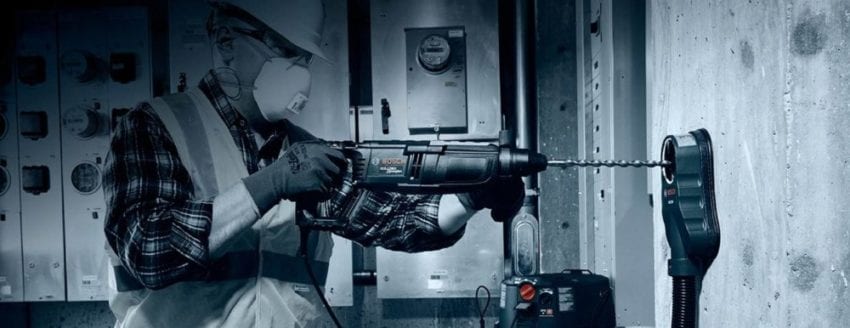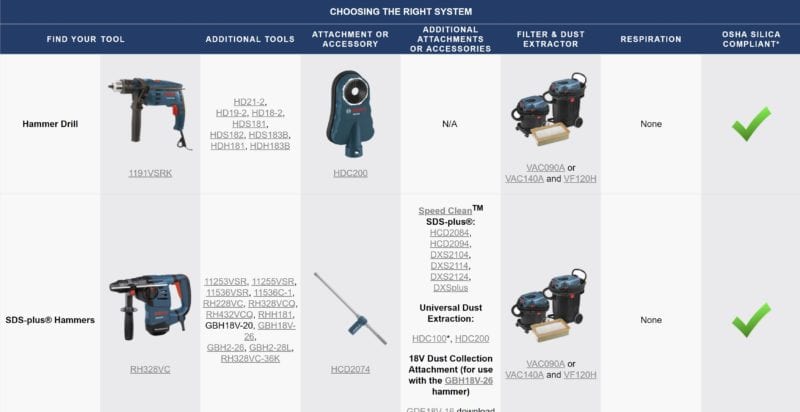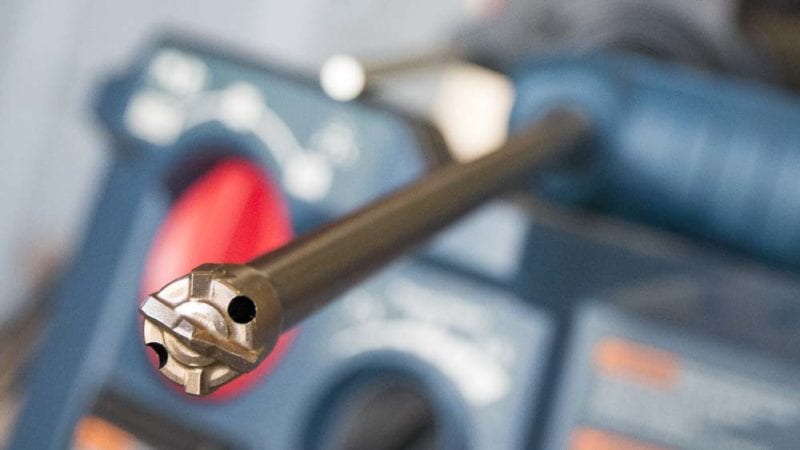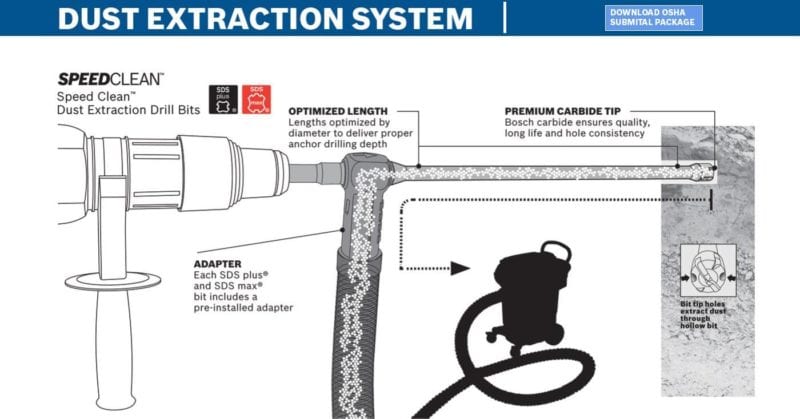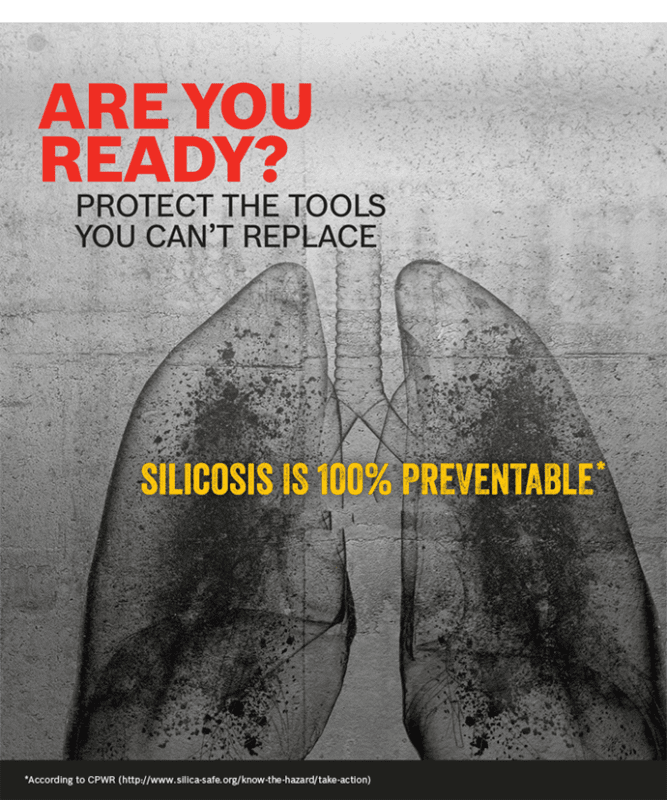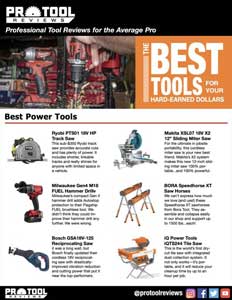Back in early 2017, OSHA announced new silica dust regulations and Bosch was the first company to proactively contact us to start the push toward education before the September 23rd deadline. That date has come and gone, but there’s still plenty of confusion running around about what you need and what you don’t. To help, there’s a Bosch Table 1 compliance website set up to help you ensure you’re OSHA-compliant for concrete work.
There’s a lot of information to digest, but we’re breaking it down so you know exactly what you’ll find for the kind of work you’re doing. Just give the link in each section a click and it will take you right to Bosch’s page so you don’t have to search too hard.
Table of contents
- Table 1 Compliance for OSHA Silica Dust Regulations
- Choosing the Right Tools for OSHA Table 1 Compliance
- OSHA Table 1 Compliance for Concrete Drilling
- Concrete Demolition and Table 1
- Silica Dust Regulations for Surface Grinding
- Concrete Cutting
- Masonry and Tuckpointing OSHA Silica Dust Compliance
- Objective Data Downloads
- More Silica Dust Resources
Table 1 Compliance for OSHA Silica Dust Regulations
There’s a ton of information available on OSHA Table 1 compliance on the Bosch website, and we’ll go into each section in detail. If you just want a quick overview and go navigate yourself, here’s what you’ll find:
- Bosch Pro+Guard Application Specific Solutions: 5 specific concrete applications
- Table 1 Compliance Hotline: 1-800-416-9608
- OSHA Compliance Certifications Letters: Objective testing data for specific Bosch products
- Bosch Pro+Guard Product Overview Video
- Silica Dust Resources: Covers exposure, regulations, and 3M respiration solutions
- Bosch Pro+Guard Product Reference Guide: Download and/or print a copy of current Bosch Table 1 compliance products
Choosing the Right Tools for OSHA Table 1 Compliance
OSHA silica dust compliance requires choosing the right tools and accessories for the job. From the tool doing the work to the accessories it needs and attachments to dust extraction, Table 1 provides pre-approved packages to help you know you’re compliant before the job ever starts.
OSHA Table 1 Compliance for Concrete Drilling
This site breaks down the hammer drill, SDS-Plus rotary hammer, and SDS-Max rotary hammer choices with plenty of corded and cordless models available. You’ll see an example in the first column followed by other models that will also work. The model numbers on are linked so you can just click on them and go straight to the product page for more information.
All manufacturers with serious concrete tools really need something that covers Table 1 compliance.
Moving to the right, you’ll see the accessories and attachments you’ll need. For hammer drills, you’ll be turning to a dust shroud like the Bosch HDC200. Attach it to the end of your dust extractor hose, turn the vac on, and stick the shroud to the point where you’ll be drilling. From there, you just drill away and the shroud/vac combo takes care of the dust.
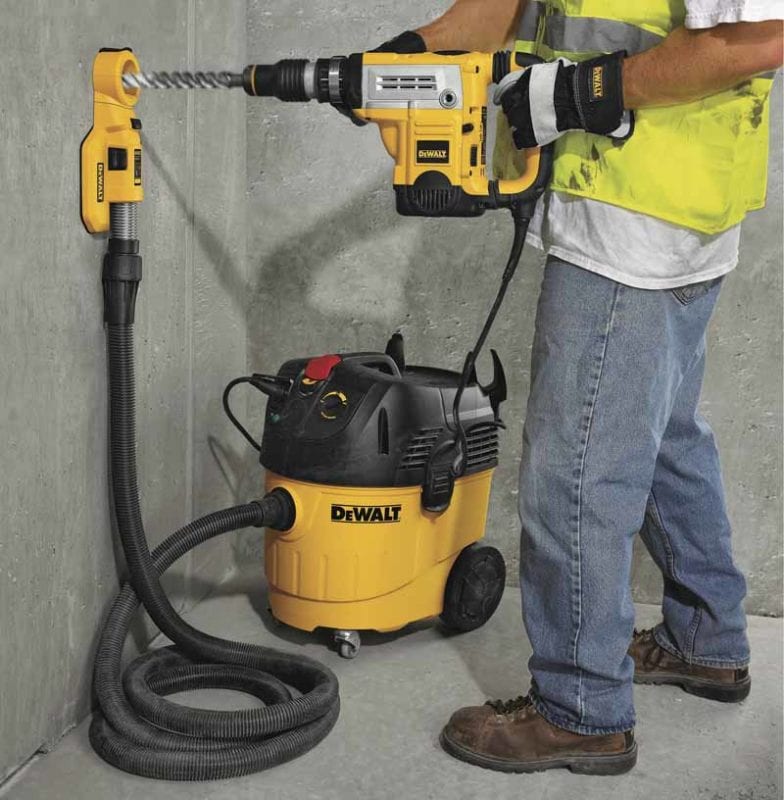
Moving onto the rotary hammers and spline hammers, you’ll notice that Bosch recommends you go their SpeedClean SDS-Plus and SDS-Max bits. You’re collecting the dust at the point of creation with those, greatly simplifying the process.
If they don’t make the specific bit size you need or you want a different option, there are also dust shrouds. And some tools have options for the use of onboard dust extractors.
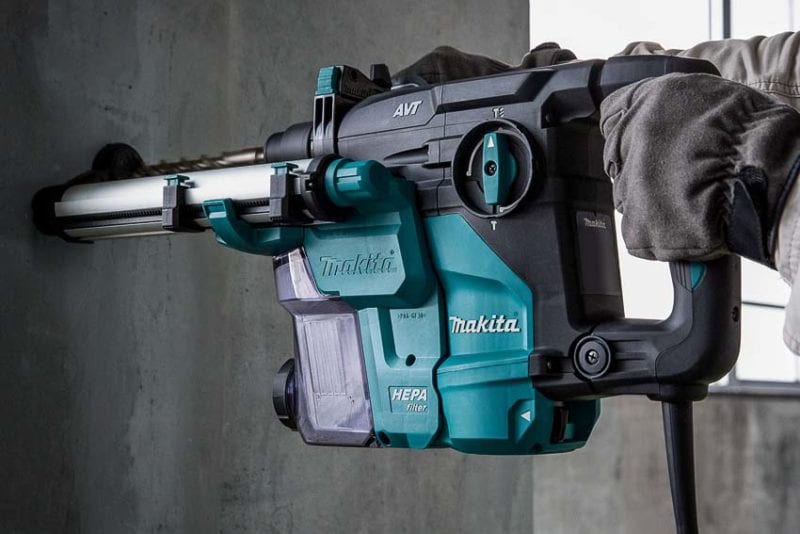
Onboard dust extraction lets you drill into walls—even overhead—without dealing with excessive silicon dust exposure. We love anything that limits when and how you have to wear a mask. In some cases, it’s always good to have extra protection, but power tools have come a long way in just a handful of years. If you can eliminate a bulky respirator and replace it with an N95, that’s a huge win for concrete professionals.
Concrete Demolition and Table 1
On the demolition side of OSHA Table 1 compliance, demo tools like SDS-Max and spline hammers, demolition hammers, and breakers specify products that meet the required dust extraction specs. Attachments go close to the point of contact to catch the dust that shoots out while bigger chunks fall away.
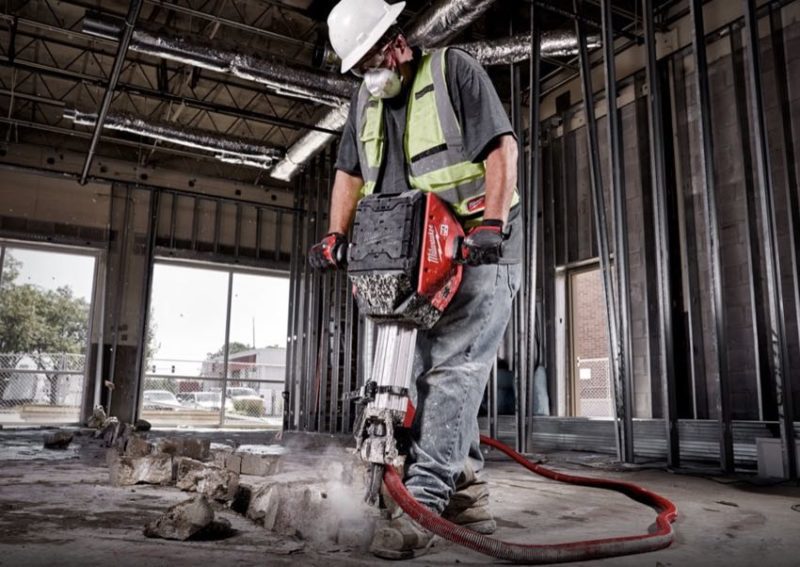
Dust extraction options remain the same with these tools, but you still need respiration if you’re doing indoor demolition or working for more than 4 hours on a shift.
Table 1 Compliance Tip: 4 hours of demo work per shift doesn’t mean that you’re tasked with demo work for 4 hours. It means that you’re doing 4 continuous hours of breaking in a shift. It doesn’t count the time that the tool isn’t actively working on demo. That’s a big factor when it comes to whether or not you’ll actually need a respirator.
Silica Dust Regulations for Surface Grinding
It should come as no surprise that there are plenty of Table 1 options in the surface grinding category. One way to go is with a concrete surface grinder that includes a dedicated dust collection shroud. That removes the need for additional accessories. Just connect it to your dust extractor and check your respirator requirement.
The rest of the grinders are broken into the 5-, 7-, and 9-inch classes. Those are important distinctions because of dust extractor requirements.
Table 1 Compliance Tip: You need 25 CFM for every 1″ of grinder wheel. A 5″ grinder needs 125 CFM minimum, while a 9″ grinder needs 225 CFM. However, it’s about the wheel size, not max wheel size. If you use a 7″ wheel on a 9″ grinder, you only need 175 CFM.
In most cases, you need to add a dust shroud to the grinder. Some manufacturers recommend using the same 7-inch shroud and wheel for both their 7- and 9-inch grinders. That keeps you at needing just 175 CFM on your dust extractor since you’re working with a smaller wheel than the 9-inch grinder can potentially accept.
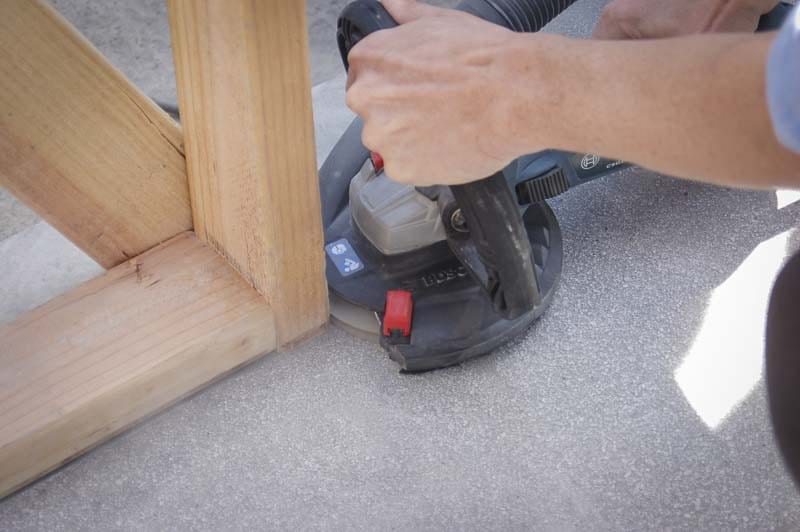
One other point, some dust extractors top out at around 150 CFM. That’s great for most portable dust extractors, but when moving up to the 7- or 9-inch class, you need to look for more powerful machines.
The respiration requirements are the same as with demolition. If you’re working indoors or for more than 4 continuous hours, you’ll need to wear a respirator.
Concrete Cutting
Table 1 compliance for concrete cutting solutions is very similar to the surface grinding category. There are fewer grinders to choose from, but still plenty there, and we see the introduction of the 6-inch grinder class.
The attachments change from horizontal to vertical shrouds to accommodate dry concrete cutting. We see that many 6-inch grinders will use a 5-inch shroud much like a compliant 9-inch grinder may drop to 7-inches on surface grinding.
Dust extraction options remain unchanged, including the requirement for additional dust extractor CFM on the 7″ and 9″ grinders. Again, respirators are only required for indoors and 4+ hours of continuous use.
Masonry and Tuckpointing OSHA Silica Dust Compliance
Tuckpointing is our last application-specific category for OSHA Table 1 compliance. There are a couple of tuckpointer models to choose from that don’t require additional accessories. You also have 4-1/2″ to 6″ grinders you can add shrouds to.
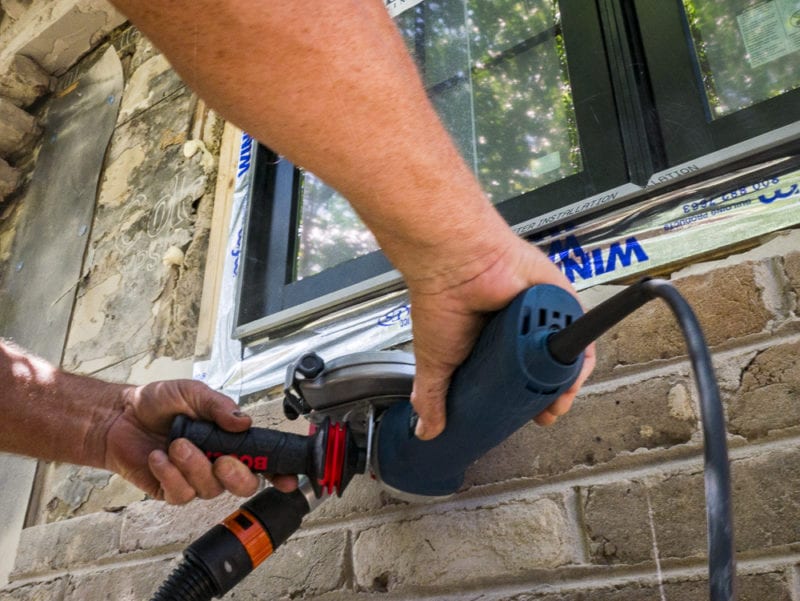
Dust extraction stays the same, and manufacturers like Bosch are able to cover all of the grinder sizes in this category. What takes a drastic change here is respiration requirements. Whether you’re tuckpointing for 30 seconds or all day, you have to wear a respirator.
Objective Data Downloads
If you’re going to be drilling, chiseling, demoing, grinding, cutting, or tuckpointing in concrete, it’s helpful for manufacturers to have objective data compliance letters. With these prepared in a downloadable format for various accessory packages, tradesmen and companies can access them when needed. Ideally, you’d find the one you need and download or print it.
More Silica Dust Resources
Have a crew member that’s just not taking silica dust seriously? Or maybe you’re not so sure why it’s such a big deal? Check out this easy-to-read breakdown of the dangers of silica dust exposure.
You can also head over to the 3M website to check out their respiration solutions.
You want to locate breakdowns of essentially every tool, accessory, and dust extractor requirement for OSHA Table 1 compliance. Preferably, your tool company of choice will put that into a handy downloadable PDF. If not—contact them and request it!
A list of compliant tool and accessory combos is handy to have on hand at the jobsite. A printed copy also makes all that information much easier to access or even digest as opposed to scrolling through a website. Either way, it’s a great resource have on hand. Don’t forget that you can find additional resources from the OSHA website.

